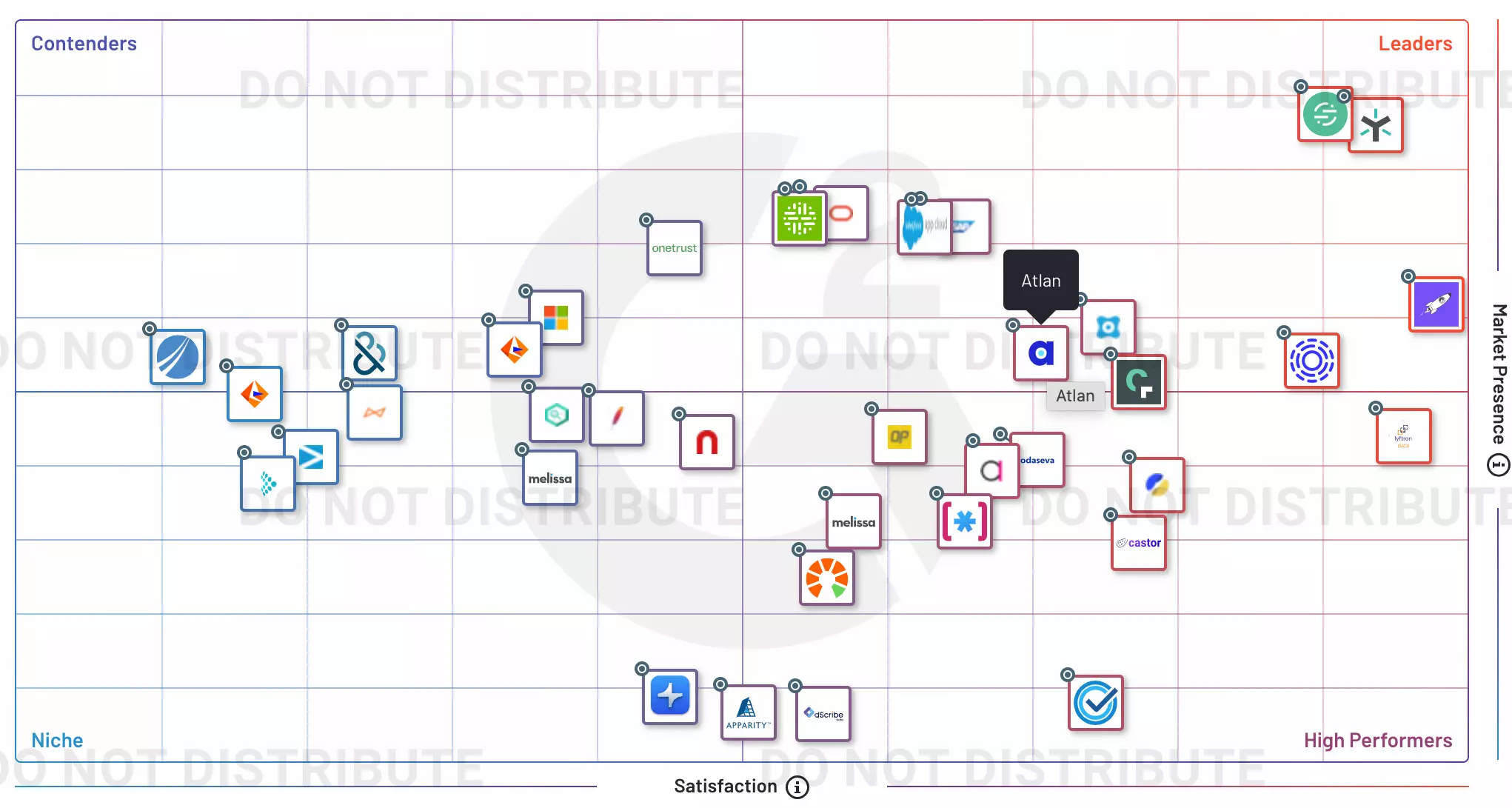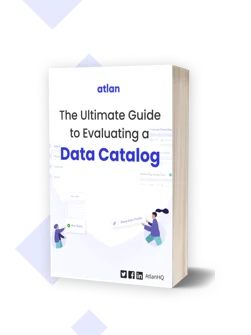The G2 Grid® Report for Data Governance: How Can You Use It to Choose the Right Data Governance Platform for Your Organization?

Share this article
The G2 Grid® Report for Data Governance is a useful resource for businesses assessing and comparing different data governance solutions.
The framework considers a range of factors, including user reviews and third-party data sources, and applies G2’s unique algorithm (v3.0) to evaluate the most popular B2B data governance products in the market.
Table of Contents #
- What is the G2 Grid® Report for Data Governance?
- How is the G2 Grid® Report calculated?
- How to interpret the G2 Grid® Report for Data Governance
- Most important features to consider when researching data governance products
- Wrapping up
- Related reads on G2 Data Governance
Let’s look at the framework and evaluating criteria to know more.
What is the G2 Grid® Report for Data Governance? #
The G2 Grid® Report for Data Governance is a framework to evaluate data governance products to ensure the availability, usability, and integrity of data.
The grid uses several factors, such as market presence, customer satisfaction scores, as well as data aggregated from online sources and social networks to assess B2B data governance solutions.
G2 emphasizes that the Grid® represents “the democratic voice of real software users, rather than the subjective opinion of one analyst.”
You can use the G2 Grid® to compare the various B2B data governance products and streamline your buying process for data governance solutions.

The G2 Grid® Report for Data Governance. Source: G2
How is the G2 Grid® Report calculated? #
G2 looks at user reviews, publicly available information, and third-party sources to prepare a comprehensive assessment of each product listed in its grid.
According to G2:
“G2 rates products and sellers based on reviews gathered from our user community, as well as data aggregated from online sources and social networks. We apply a unique algorithm (v3.0) to this data to calculate the Satisfaction and Market Presence scores in real-time.”
The G2 Grid® Report for Data Governance considers two key factors:
- The satisfaction score aggregates the scores for a product’s category, with core categories receiving greater weight than supplementary categories. The score is affected by:
- Customer satisfaction with end user-focused product attributes based on user reviews
- Popularity and statistical significance based on the number of reviews received by G2
- Quality of reviews received (reviews that are more thoroughly completed will be weighted more heavily)
- Age of reviews (more-recent reviews provide relevant and up-to-date information that is reflective of the current state of a product)
- Customers’ satisfaction with administration-specific product attributes based on user reviews
- Overall customer satisfaction and Net Promoter Score (NPS) based on ratings by G2 users
- The market presence score measures the product’s market share, vendor size, and influence in the data governance category. It’s a combination of 15 metrics from G2’s reviews, publicly available information, and third-party sources. Some of the key criteria include:
- Number of employees (compiled from social networks and public data sources)
- Reviews
- Web and social presence
- Growth (in terms of employees and digital presence)
How to interpret the G2 Grid® Report for Data Governance #
The G2 category Grid® Report for Data Governance is mapped with two axes, namely market presence and customer satisfaction.
The grid is further divided into four quadrants:
- Leaders: Well-established tools with a high market presence and customer satisfaction
- High Performers: Show good potential but have a lower market presence
- Contenders: Traditional tools with a high market presence but low customer satisfaction
- Niche: Less well-known tools with limited functionality
Let’s understand each quadrant of the grid further.
G2 Grid® for Data Governance: The Leaders quadrant #
Tools in the Leaders quadrant, like Atlan, have high customer satisfaction ratings and a high market presence.
These tools are considered to be the most comprehensive and mature for data governance.
They’re ideal for large enterprises with complex data environments requiring extensive data security, privacy, and compliance capabilities.
G2 Grid® for Data Governance: The High Performers quadrant #
The tools in the High Performers quadrant, like Avo, have high customer satisfaction ratings but a lower market presence.
These tools are relatively new to the market but still offer powerful data security and compliance capabilities.
They’re ideal for smaller businesses with significantly less complex data environments, as compared to large enterprises. These tools might not offer the same amount of features as the tools in the Leaders quadrant as their use cases might still be evolving.
G2 Grid® for Data Governance: The Contenders quadrant #
The tools in the Contenders quadrant, like Informatica, have a high market presence but lower customer satisfaction ratings.
While these tools may offer mature capabilities for data governance and have an established market presence, they may not be easy to use and don’t offer extensive customer support.
Their popularity comes from legacy customers as these tools have been around for a while. However, they struggle to keep up with modern, intuitive, and cloud-agnostic data governance platforms like Atlan.
G2 Grid® for Data Governance: The Niche quadrant #
Tools in the Niche quadrant, like Melissa Clean Suite, have both low customer satisfaction ratings and a lower market presence.
These tools are either too new to the market or cater to a specific set of use cases. They’re also limited in their capabilities when compared with the more mature tools in the Leaders or High Performers quadrant.
According to G2, “while they may have positive reviews, they do not have enough reviews to validate those ratings.”
They may be ideal for small teams requiring compact data governance tools to solve very specific problems in data security, privacy, or compliance.
The most important features that data practitioners are considering when researching data governance products #
The G2 Grid® Report analyzes several capabilities to rank data governance solutions. These include:
- Data lifecycle management: The product should help you map data lineage across all systems and applications, down to a column level. You should be able to bring in any data product you want using open APIs. The product should also let you propagate policies, tags, and more via the lineage automatically.
- Capabilities to outline and implement data governance: The product should support role-based access by allowing you to set up customized profiles for each data practitioner, domain, or project. So, you can build policies around who your data users are, which teams they work in, and what projects they’re working on.
- Capabilities to enforce data standards and compliance requirements: The product should allow you to define data and metadata policies to control who can view, edit, or query your data, definitions, metric formulas, and business taxonomies. You should also be able to attach policies to custom classifications, like PII and GDPR, to ensure compliance at scale.
- Recommendations to improve governance processes: According to G2, data governance tools should provide recommendations to increase efficiency and streamline processes. These may include auto-suggesting tags, owners, data descriptions, policies, and more.
Wrapping up #
The G2 Grid® for Data Governance covers several products that will help you improve the overall security, integrity, and privacy of your data while ensuring regulatory compliance.
Regardless of the product you choose, it should allow you to monitor, manage, and control data movement across your data estate effectively.
In addition, the product should meet your business requirements and be easy to set up and use.
Also, read → Atlan debuts as a leader in 3 categories — data governance, machine learning data catalogs, and data quality
Related reads on G2 Data Governance: #
- What is Data Governance? It’s Importance, Principles & How to Get Started?
- Data Governance Framework — Examples, Templates, Standards, Best Practices & How to Create One?
- Snowflake Data Governance — Features, Frameworks & Best practices
- Open Source Data Governance Tools - 7 Best to Consider in 2023
- Data Governance Policy: Examples, Templates & How to Write One
- Data Governance Roles and Responsibilities: A Quick Round-Up
- A Guide to Gartner Data Governance Research — Market Guides, Hype Cycles, and Peer Reviews
- Automated Data Governance: How Does It Help You Manage Access, Security & More at Scale?
- Data Governance and Compliance: Act of Checks & Balances
- Enterprise Data Governance — Basics, Strategy, Key Challenges, Benefits & Best Practices.
Share this article












